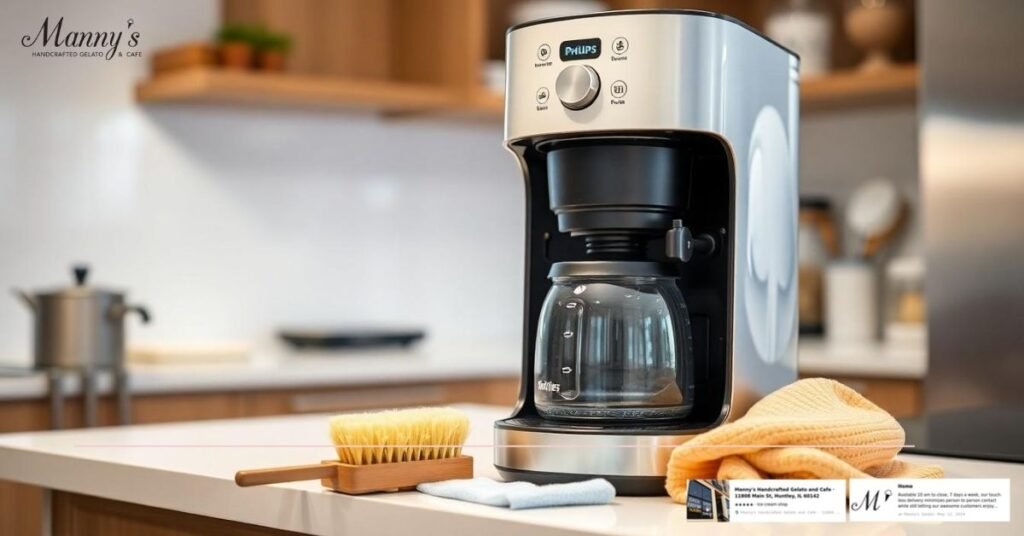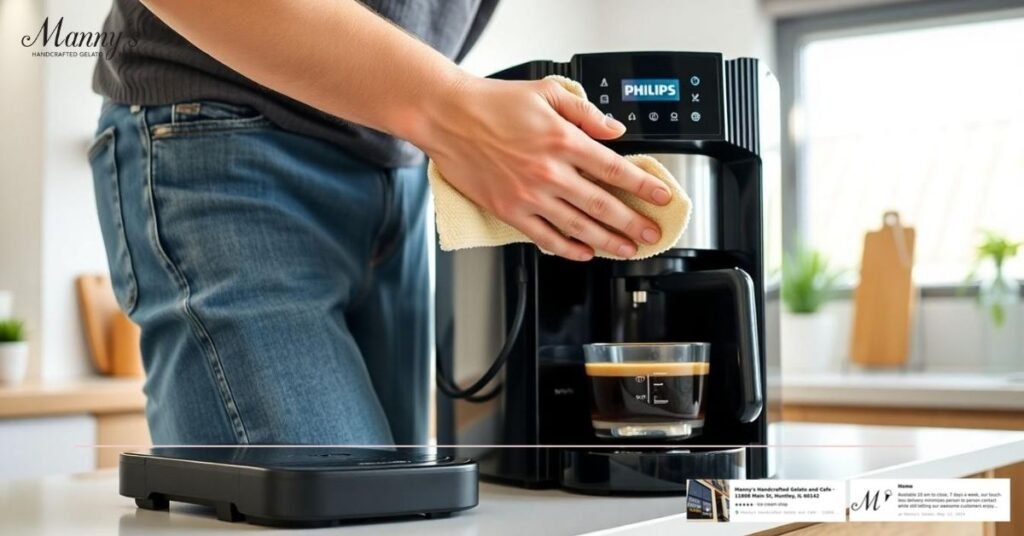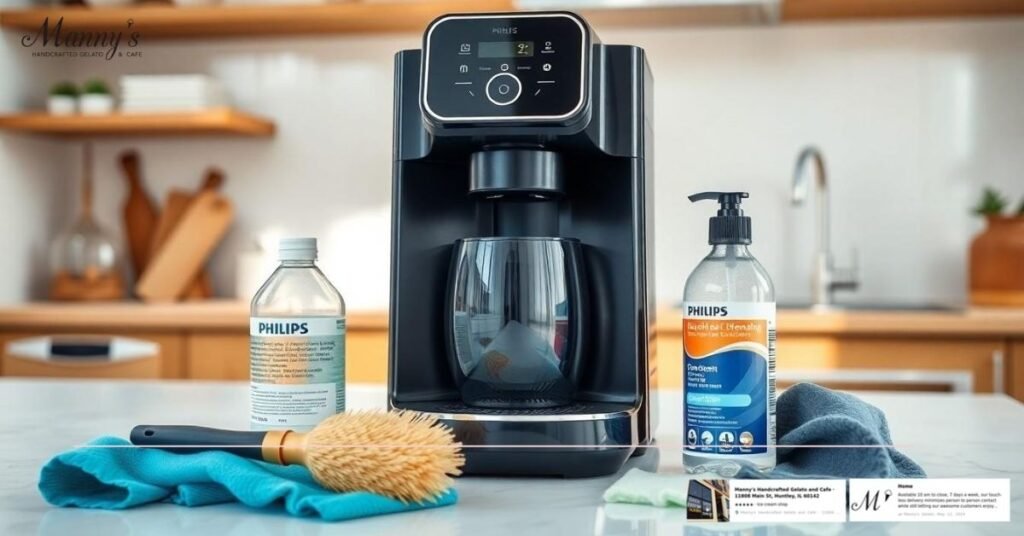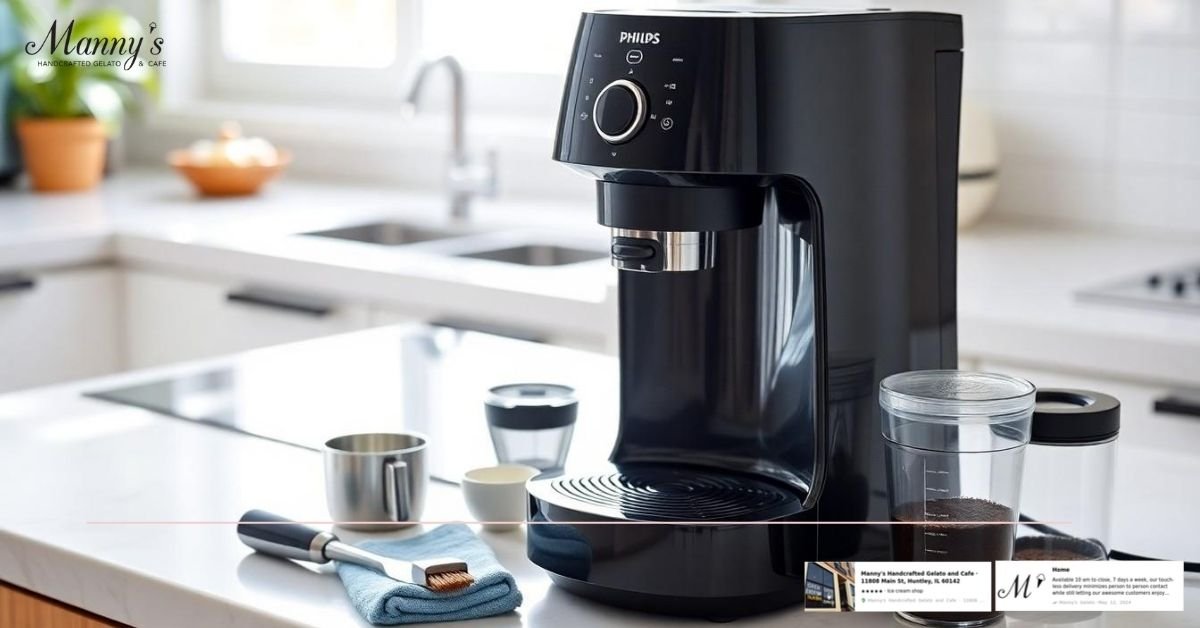- Regular cleaning of a Philips coffee machine is essential for better-tasting coffee, efficient performance, and extended machine lifespan.
- Use Philips-recommended cleaning products like descaling solutions, brewing unit cleaning tablets, and milk circuit cleaners to maintain optimal functionality.
- Clean detachable parts, including the drip tray, coffee grounds container, and water reservoir, weekly to prevent buildup and ensure hygiene.
- Pay attention to internal components such as the brew group and coffee oil residue, cleaning them regularly for consistent coffee quality and to avoid clogging.
- Descale the machine every 1,000 cups or as prompted to combat limescale buildup and maintain efficiency.
- Create a consistent cleaning schedule and use proper tools and products to make maintenance simple and effective.
We all love the perfect cup of coffee, and our Philips coffee machines make it so easy to enjoy barista-quality brews at home. But to keep those delicious flavors coming, regular cleaning is a must. A clean machine doesn’t just ensure better-tasting coffee—it also helps extend its lifespan and keeps it running smoothly.
Let’s face it, though: cleaning a coffee machine can feel like a chore if we’re not sure where to start. Don’t worry—we’ve got you covered. With a few simple steps and the right tips, keeping our Philips coffee machine spotless and efficient is easier than we think.
Materials Needed
Gathering the right materials ensures effective and efficient cleaning of Philips coffee machines. It minimizes effort while maintaining performance.
Cleaning Products
- Descaling solution: Essential for removing limescale buildup. Philips branded solutions are highly recommended.
- Brewing unit cleaning tablets: Necessary for deep cleaning brewing components to eliminate coffee residue.
- Milk circuit cleaner: Needed for cleaning milk frothers or latte-go systems to remove milk residue.
- Mild dish soap: Useful for cleaning smaller, washable parts without harsh chemicals.
Tools and Accessories
- Soft-bristled brush: Ideal for cleaning hard-to-reach areas like coffee outlets or grinders.
- Microfiber cloth: Perfect for wiping external surfaces to prevent scratching.
- Measuring cup: Allows for accurate dilution of cleaning products during descaling.
- Container or drip tray: Required to collect water and cleaning solutions during rinsing or descaling cycles.
By following these guidelines for assembling cleaning materials, maintaining a Philips coffee machine becomes straightforward and hassle-free.
Preparing Your Philips Coffee Machine for Cleaning

Proper preparation ensures effective cleaning. Follow these steps to ready the machine for maintenance.
Turning Off and Unplugging the Machine
Switch the machine off completely before cleaning. Press the ON/OFF button and ensure all sounds have stopped. For models with a main switch, set it to OFF (0); otherwise, disconnect the power cord from the outlet.
Removing Detachable Parts
Detach and clean removable components regularly.
- Drip Tray and Drip Tray Cover: Empty the drip tray when the red indicator shows it is full. Wash it under warm tap water using mild dish soap or place it in the dishwasher.
- Coffee Grounds Container: Remove and empty the coffee grounds container as soon as the machine alerts you.
Cleaning the External Components

Regularly cleaning the external parts of a Philips coffee machine ensures its longevity and maintains its appearance. Follow these steps to keep the outer components clean and hygienic.
Wiping Down the Exterior
Use a damp cloth to clean the front of the machine, removing visible coffee stains and ground coffee residues. Perform this step weekly to prevent buildup. For the bean container and grinder outlet, wipe the interior surfaces with a damp cloth, then dry them thoroughly with a dry cloth to avoid moisture accumulation.
Cleaning the Water Reservoir
Rinse the water tank under running tap water each week to remove impurities and prevent residue buildup. After rinsing, refill it with fresh water before reinserting it into the machine, ensuring it is ready for the next use.
Tips for Maintaining a Spotless Exterior
Empty the drip tray daily or immediately when the red “drip tray full” indicator appears to avoid overflow and keep the machine clean. Regular attention to these external components helps maintain the coffee machine in excellent condition.
Cleaning the Internal Components

Keeping the internal components of our Philips coffee machine clean ensures optimal performance and prolongs its lifespan. Regular attention to these parts maintains the quality of our coffee.
Cleaning the Brew Group
The brew group requires weekly cleaning. Remove it from the machine after turning it off and rinsing it under lukewarm water. Avoid using any cleaning agents, as they can damage the component. After rinsing, allow the brew group to air dry completely before reinserting it into the machine. Every month, use a brewing unit cleaning tablet to thoroughly clean the internal passages and ensure consistent coffee flavor.
How to Clean Coffee Oil Residue
Coffee oil residue can build up over time, affecting the taste of our coffee. Use a soft-bristled brush to gently scrub the areas where residue is most likely to accumulate, such as the coffee funnel. For stubborn deposits, apply a damp cloth and a safe coffee machine cleaning product. Make sure to clean this residue as part of our regular maintenance schedule to prevent clogging and flavor impact.
Descaling the Machine
Descaling combats limescale buildup, preserving the machine’s efficiency. Use the specific descaling solution recommended by Philips and follow the instructions provided in the user manual. Start the descaling process through the machine’s built-in menu and ensure the drip tray is empty before beginning. This process typically takes about 30 minutes, after which thoroughly rinse the water reservoir and run a cycle with fresh water to remove any remaining solution traces. Descale every 1,000 cups or when the machine prompts us to, whichever comes first.
Sanitizing the Milk Frother (If Applicable)

Cleaning the milk frother on a Philips coffee machine ensures hygienic, high-quality milk foam and prolongs the machine’s lifespan. Follow these steps to maintain your frother effectively.
Tips for Proper Milk Frother Maintenance
- Daily Cleaning: After usage, dispense hot water through the milk frother while it remains attached to the machine. This helps clean any milk residue from the inner components.
- Disassembly: Remove the milk frother and disassemble all parts. For classic frothers, clean the lid, silicon ring, and additional components under running water or in the dishwasher. For automatic frothers, unplug the device, remove the pitcher, and wash the lid and silicon ring using mild detergent. Keep the base dry to prevent damage.
- Routine Checks: Inspect the parts regularly for wear or damage. Replace any compromised components promptly to avoid hygiene issues.
Ensuring Hygienic Milk Frothing
- Thorough Cleaning: Perform detailed cleaning if milk residue accumulates. Disassemble the frother and scrub parts with mild dish soap and warm water.
- Avoiding Moisture on Electronics: For automatic models, ensure the base remains moisture-free during cleaning.
- Drying: Allow all cleaned components to air-dry completely before reassembly. This reduces the risk of bacterial growth.
By adopting these practices, we sustain cleaner operations and enjoy consistently frothy, hygienic milk foam.
Troubleshooting Common Cleaning Issues

Even with regular cleaning, some issues may arise that impact the performance or appearance of our Philips coffee machines. By addressing these promptly, we can maintain efficiency and quality.
Dealing with Hard-to-Remove Stains
Stains on the machine’s exterior or internal parts sometimes resist standard cleaning methods. For such stains, use a mixture of lukewarm water and mild dish soap. Apply this solution with a microfiber cloth to gently scrub until the stains fade. For persistent discoloration inside removable components, such as the drip tray or water tank, let them soak in the soapy solution for 10-15 minutes before scrubbing and rinsing thoroughly.
Addressing Persistent Blockages
Persistent blockages may occur in the coffee outlet or milk frother if residue accumulates. To clear a blocked coffee outlet, use a cleaning pin or a soft-bristled brush to remove residue. If the milk frother seems obstructed, disassemble it and soak its parts in warm water. Clean each component with a small brush, then rinse and reassemble. Running a descaling cycle can also help resolve blockages caused by limescale buildup in internal pipes.
What to Do If the Machine Shows Maintenance Alerts
When the machine displays maintenance alerts, prompt action ensures continued functionality. If the descaling alert appears, perform the descaling process using Philips’ descaler solution. Follow the instructions in the user manual and rinse the tank thoroughly after completing the cycle. If the notification indicates that the brew group needs cleaning, remove it, rinse it under lukewarm water, and reinsert it until it clicks securely into place. For other alerts, consult the machine’s manual or Philips’ official support resources.
Tips for Regular Maintenance

Consistent care ensures our Philips coffee machine continues to deliver great coffee and operates efficiently. Implementing a cleaning schedule and selecting the right supplies simplifies maintenance tasks.
Setting Up a Cleaning Schedule
Establishing a cleaning routine keeps our machine in peak condition. For daily tasks, empty the drip tray whenever the red “drip tray full” indicator appears and rinse it with mild dish soap or place it in the dishwasher if compatible. Wipe the hot water/steam wand with a damp cloth after every use and run the steam function for 5-10 seconds to rinse its internal pipe.
For weekly maintenance, rinse the water tank and wipe the machine’s exterior using a soft cloth to remove stains and residues. Clean the coffee funnel for smooth operation, using a spoon to clear obstructions in the coffee grinder through the pre-ground compartment. Sticking to this schedule reduces the likelihood of clogs and performance issues.
Choosing Proper Cleaning Supplies
Using compatible cleaning materials is essential to prevent damage to the machine. Opt for Philips-recommended descaling solutions to combat limescale buildup effectively. Use brewing unit cleaning tablets monthly for internal cleanliness. Select milk circuit cleaners for hygienic milk frother maintenance and mild dish soap for cleaning detachable components like the drip tray and water tank.
For tools, keep a soft-bristled brush to clean residue from internal components. Use a microfiber cloth for wiping external surfaces to avoid scratches and prepare a measuring cup and container for rinsing tasks. These supplies ensure both thorough cleaning and the machine’s longevity.
Conclusion
Keeping our Philips coffee machine clean doesn’t have to be overwhelming. With the right tools, a little consistency, and a clear routine, we can enjoy delicious coffee every day while ensuring our machine stays in top shape. Regular care not only enhances the taste of our coffee but also protects our investment for years to come.
Let’s make cleaning part of our coffee ritual. A well-maintained machine means fewer issues, better performance, and, most importantly, consistently great coffee. It’s a small effort that goes a long way toward keeping our coffee experience enjoyable and hassle-free.
Frequently Asked Questions
How often should I clean my Philips coffee machine?
Regular cleaning is essential. You should clean the drip tray and rinse the water reservoir daily, clean the brew group weekly, and descale the machine every 1,000 cups or when prompted. Following a proper cleaning schedule ensures optimal performance and coffee quality.
What materials do I need to clean my Philips coffee machine?
You’ll need descaling solutions, brewing unit cleaning tablets, milk circuit cleaners, mild dish soap, a soft-bristled brush, a microfiber cloth, a measuring cup, and a container for rinsing. These tools help simplify cleaning tasks and ensure effective maintenance.
Can I put Philips coffee machine parts in the dishwasher?
Yes, certain parts like the drip tray and coffee grounds container can go in the dishwasher. Always check the user manual for which components are dishwasher-safe to avoid damage to the machine.
How do I clean the brew group?
Remove the brew group, rinse it under lukewarm water without any cleaning agents, and air dry it thoroughly. For a deeper clean, use Philips’ brewing unit cleaning tablets once a month, following the manual’s instructions.
Why is descaling important for my coffee machine?
Descaling removes limescale buildup caused by hard water, improving machine performance and extending its lifespan. Use Philips’ specific descaling solution and follow the manufacturer’s recommendations for descaling frequency.
How do I ensure the milk frother stays clean?
Dispense hot water through the frother daily after use and disassemble and wash its parts regularly. For stubborn milk residue, soak the parts in warm water. Always check for wear and keep the base dry to maintain hygiene.
What should I do if coffee outlets get blocked?
Use a cleaning pin or soft-bristled brush to gently clear blockages in coffee outlets. For serious blockages, soak removable parts in warm water and clean carefully to restore functionality.
How do I prevent coffee oil buildup?
Regularly clean the coffee funnel and brew group with a soft-bristled brush to remove coffee oil residue. Wipe the machine’s interior and external components weekly with a damp microfiber cloth for pristine results.
What are the best products for cleaning Philips coffee machines?
Philips-recommended cleaning supplies, such as descaling solutions, cleaning tablets, and milk circuit cleaners, are ideal. Avoid harsh chemicals or abrasive tools to prevent damage to your machine.
What should I do if my machine displays a maintenance alert?
Maintenance alerts indicate tasks like descaling or cleaning the brew group. Follow the instructions on the machine or refer to the user manual for detailed guidance to resolve the issue promptly.
